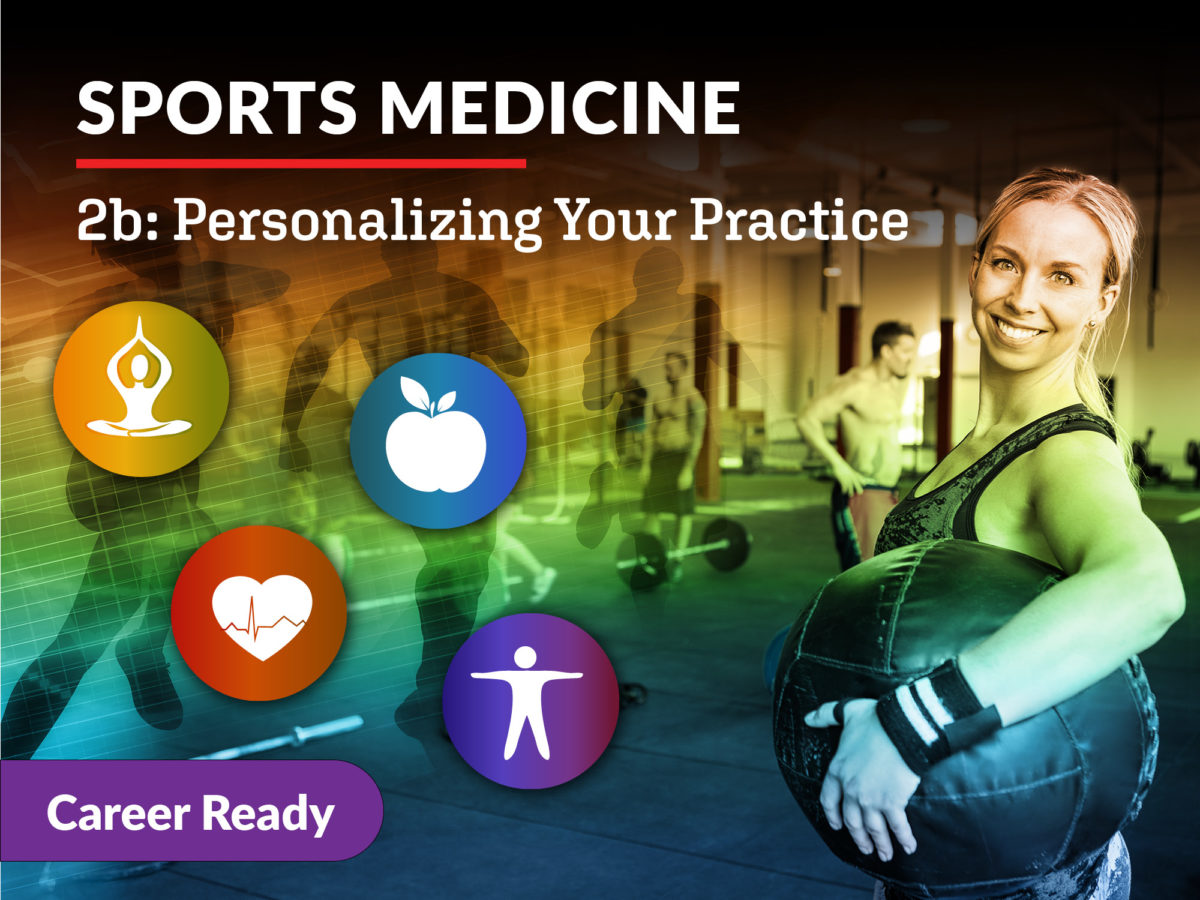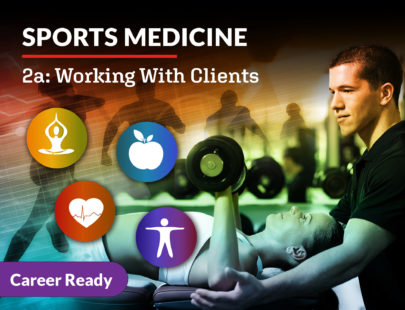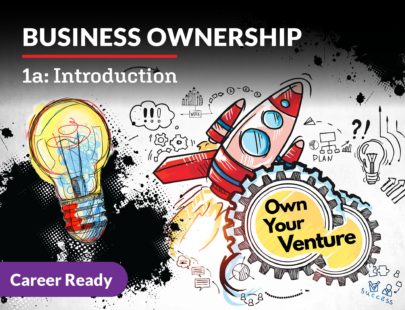
Sports Medicine 2b: Personalizing Your Practice
“Five, four, three, two, one—rest.” You’ve learned what it looks like to work one-on-one with clients as a sports medicine professional, and now it’s time to focus on the group. In this course, you will be introduced to teaching group exercise classes and providing rehabilitation services to clients facing injury and disease. You will also learn about laws that govern the work of sports medicine professionals, business concerns like insurance and staffing, and what you need to consider if you start your own fitness facility. It looks like it’s time for the next set! Let’s get started!
Units at a Glance
Unit 1: Preparing for a Group Exercise Class
If you’ve ever attended a group fitness class like aerobics, dance, spinning, barre, or HIIT, you know that when all the factors are right you leave the class feeling amazing—like you could conquer the world! Yes, exercise-induced endorphins are partially to thank for this, but the behind-the-scenes work of your exercise instructor is also critical to the comfort and success of class participants, even though these factors don’t have anything to do with the actual physiological changes in the body. Or do they? Does the music selection make a difference in your desire to move? Can the temperature of the room help determine your level of effort? Does the volume, tone, pitch, and projection of the instructor’s voice increase your ability to persevere through pain-producing isometric holds, when all you want to do is quit? These are all considerations the instructor thinks about as they prepare for a group fitness class.
What will you learn in this unit?
- Understand the standards and scope of the code of ethics for sports medicine professionals involved in group fitness classes
- Determine the correct classroom environments for the type of group fitness class you are leading
- Design exercises for a specific type of group class, making sure to include the principles in FITT-VP
- Follow guidelines for music selection, according to tempo or phrasing, copyright, and demographics
- Train your voice for better projection when instructing and encouraging your group members
Unit 2: Teaching Group Exercise Classes
Teaching is communication, so to be an effective group fitness instructor, you must first understand yourself and how you communicate. Are you loud and tough or energetic and bubbly? Do you avoid conflicts or address them right away? Once you determine how you want to present yourself in front of a group, it’s time to turn your attention to your clients and the ways they learn. Support participants by cueing them at just the right time to help them finish a hard move or to show them you noticed their perseverance. Cheerleader, expert, coach—you wear lots of hats as a fitness instructor, but you can handle it!
What will you learn in this unit?
- Adopt a teaching style that fits your personality and supports your clients’ various learning styles
- Cue participants effectively to help them maximize their workouts
- Address concerns about group dynamics through conflict resolution
- Modify class plans as needed to maximize client success
- Propose new community-based exercise opportunities to reach clients in need
Unit 3: Creating Exercise Plans for Diverse Groups
In our perfect fitness world, everyone would love to exercise and be able to execute all movements perfectly. However, when you step into your classroom—in other words, “the real world”—you’ll notice that there are likely a few participants who don’t seem to even need an instructor, while the rest lean on you for support. Those who need your support might desperately want to be more physically fit, or maybe they were told by family or physicians to get in shape. No matter their reasoning, they need you, and to reach them, you’ll have to use your knowledge of anatomy and best teaching practices in unique ways.
What will you learn in this unit?
- Identify general modifications that can be made to fitness class plans, including tempo and alternate exercises
- Design classes that reduce the risks for pregnant women, children, adolescents, and aging clients
- Determine how to modify group exercises for clients with cardiovascular or respiratory conditions
- Create a fitness routine that helps clients with metabolic diseases
- Construct workouts for people with skeletal issues, joint pain, and other types of pain
- Consider how to help clients who have physical and intellectual limitations
Unit 4: Rehabbing with Exercise
Tissue damage that results in a person’s inability to be active during recovery can be devastating to their future health. Regardless of the cause of the damage, a client needs to move to fully recover. You can do something about that! You may need to wear a few different hats as you help them rehabilitate their impaired tissue. The most obvious hat is that of a trainer, whether personal or in a group setting, helping them to progress from no activity to being involved in any fitness program they desire. The second hat is for an educator, teaching clients about their anatomy and physiology and the motions they need to perform (or avoid) during rehab. The final hat? That’s for being a counselor or cheerleader. Rehab takes a long time, so be prepared to provide clients with the care, concern, and encouragement they need to work through this period of pain, fear, or frustration.
What will you learn in this unit?
- Understand the phases of rehabilitation
- Consider best rehab practices for clients after an illness
- Recognize the progression programs that will benefit the various joint tissues after injury
- Identify the therapies and rehab modalities that help treat injured tissue when used in conjunction with exercise plans
Unit 5: Trends in Sports Medicine
You’ve heard it said: “Choose a job you love, and you will never have to work a day in your life.” Being excited to go to your job every day is a blessing, and to get to this point, it is important to look critically at all aspects of your potential career. Your passion for exercise and its health benefits have shaped your decision on a career in a sports medicine field so far. Now, it’s time to consider the many paths you can take in the fitness world and what trends and techniques will let you help clients meet their goals. How will you make your mark in the fitness world?
What will you learn in this unit?
- Identify current trends in physical therapy
- Recognize developments in the field of athletic training
- Consider current ideas about coaching and personal training
- Determine which of these fields best fits your fitness interests
Unit 6: Your Responsibility: Sports Medicine Legalities
Did you know that Milan, Italy, has a law that states citizens must smile at all times except during a funeral or inside a hospital? Sometimes laws feel arbitrary, but more often than not, they are in place to protect us. In sports medicine, laws and industry standards help prevent avoidable accidents leading to injury, and they protect professionals if they are liable for a client’s injury. Unlike the law in Milan, we have to pay attention to these! It is up to you to be aware of your surroundings and make sure clients are exercising safely. Let’s look at some of the legal practicalities of working in sports medicine to make sure we’re prepared to fulfill our duty to do no harm.
What will you learn in this unit?
- Determine what it means to operate in your scope of practice, following a certain code of ethics
- Clarify what actions can be considered negligent in the health and fitness world
- Outline the steps to respond to an emergency in your facility
- Recognize federal laws pertaining to health and fitness
- Explain how OSHA ensures that facilities are safe from hazards for all employees and clients
- Decide when to seek permission or pay for content that is protected under copyright law
Unit 7: The Business of Being Fit
When you walk into a well-run health club, do you notice the office details that make it such an organized and perfectly functioning business? Probably not and, really, you shouldn’t! If a health facility has solid operating procedures in place and a good business plan, the “business” part of the organization shouldn’t even be recognizable to clients. Easier said than done, though! Getting to this point requires intentional planning and the ability to train employees to carry out that plan. Let’s start thinking about what it would actually be like to run a successful business like this!
What will you learn in this unit?
- Understand types of fitness businesses and major business procedures
- Describe how fitness facility spaces are arranged to welcome and motivate clients
- Draft a business plan and manage business finances
- Identify scheduling methods and documentation needs for your facility
Unit 8: Your Career
Sports medicine excites you. It makes you want to get out of bed to go help people. You are so energized by this field that you see yourself one day owning your own facility! Expanding on your knowledge about what it takes to own a fitness business will help you cement your plan—from finding a building or plot of land to operating within legal limits. Your future is only bound by your imagination!
What will you learn in this unit?
- Understand how to find or construct a building for your fitness center and market it to find new clients
- Establish a management style that fits with your personality and encourages staff productivity and happiness
- Discuss labor issues that could affect your fitness business
- Create a resume that markets you and your talents
Required Materials
Physical
- Video recording device
- Audio recording device
Software
- Word processing software
- Graphic design software
- Spreadsheet software
Other
- Helper
Optional
- Writing supplies
- Email software
- Presentation software






